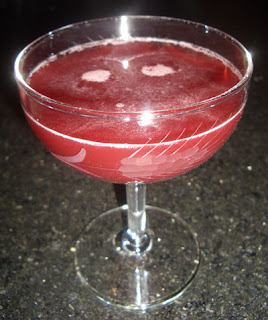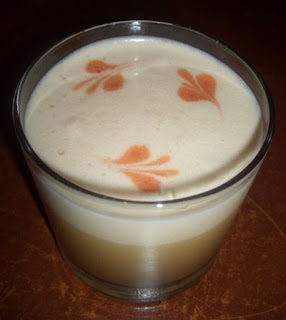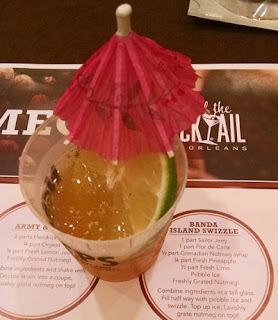Nothing is more American beverage-wise than the cocktail. And what better way to celebrate the 4th of July than being retrospective on my nation of drinks data.
While looking over the analytics that Blogger provides, I realized that there was a discrepancy between what they reported as the top posts and what the raw data is. Therefore, I searched through the 34 pages of 100 drinks per page to find out what had the top number of clicks; I weeded out non-cocktail recipe posts and also drew an arbitrary line that yielded 26 posts. This data of course is just clicks from search engines or page links and not actual reads such as through the blog front page (or successive pages after that) or through RSS feeds. Without further ado, here the top ones:
26. The
Means of Preservation is John Gertsen's riff on Teardrop Lounge's Ephemeral which elegantly put St. Germain into a stirred Martini format avec celery bitters. It still gets made enough at Drink to be referred to as merely the "MOP."
25.
Tommy Noble was created at the B-Side Lounge by Dave Cagle before it spread to other bars with its gin, Pimm's, citrus, and Peychaud's simplicity. Named after a journeyman boxer from the early 1900s, my publishing the recipe was the first time Dave Cagle was in print (so he claimed when he saw an early proof of the
Drink & Tell book). I asked Dave if he had a great interest in boxing history, and he replied that it was named after a line from a talking lizard video (
Drinking from Cups) that they were watching and making reference to at the time circa 2006.
24. The
Silent Order is No. 9 Park/Drink's Ben Sandrof's Chartreuse, citrus, and basil wonder that was intriguingly softened by including water as a jiggered ingredient to tame the 110 proof spirit.
23.
Teresa is an incredibly quirky yet well-balanced drink by home bartender Rafael Ballesteros that Gary Regan chose to highlight in his
The Joy of Mixology book.

22. The
Paper Plane is one of three drinks by Manhattan legend Sam Ross to make this list. This drink balances bourbon and lemon with two amari in an elegant equal parts number.
21. The
Knickebein is a bizarre layered drink with an unbroken egg yolk floating on top of the liqueur layer made even more bizarre by the 4 step protocol laid out by Leo Engel in 1878. I later modernized and reformulated the ingredients, and my enthusiasm for the drink scored me the honors to do the write-up for the forthcoming
Oxford Companion to Spirits and Cocktails book.
20. Gregor de Gruyther's
Nuclear Daiquiri was his most famous contribution to the cocktail world before his early demise. His upped the ante to the classic Daiquiri by specifying the rum as overproof and funky Wray & Nephew and switching the sweetener to Chartreuse and falernum; it later inspired me to morph the mix into a Mai Tai called the
Bikini Atoll.

19. The
Pink Squirrel? In the post, I made this creamy dessert from a powdered mix found in my parents' 1970s bar collection as well as with a homemade peach kernel ratafia. I need to revisit the Alexander-like recipe using Tempus Fugit's excellent crème de noyau.
18. Drink's
Hibiscus White Rum Milk Punch based off of Jerry Thomas' 1862 California Milk Punch was one of the recipes that kickstarted the Boston phenomenon of offering clarified milk punches.
17. Eric Alperin's
Chet Baker by way of Greg Rossi when he was trying to start up a program at Dalí is indeed a delightful Rum Manhattan.
16. Sam Ross's second drink, the
Sunflower is a Corpse Reviver #2 riff with the Lillet swapped for elderflower! Works great for a regular of mine with bourbon, too.

15.
Naked & Famous by Joaquin Simo while at Death & Co. is a mezcal drink that frequently gets recommended by a server at work (along with the
Division Bell) for lovers of smoky agave drinks.
14. The
Sinatra Smash by Las Vegas' Patricia Richards came to me by way of LUPEC Boston's blog after some of the members did an event with her. Whiskey, berries, and vanilla flavors surely do make for a winning combination!
13. The
Swamp Water Fix was Ted Kilpatrick's way of updating the cult 1970s Chartreuse club hit, the Swamp Water, into something higher while at No. 9 Park.

12. Sam Ross' third drink is the tasty medicine called the
Penicillin given the curing qualities of Scotch, ginger, and honey.
11. Pok Pok's
Tamarind Whiskey Sour re-inforced how well tamarind's acid complements citrus drinks!
10. The
Moroccan Old Fashioned is an excellent drink I had in Nashua, NH. It was created by now famous Boston bartender Sean Frederick just as he was getting his start behind the stick! The Berber syrup recipe he provided might be part of the post's draw.
9. The
Cradle of Life created for PKNY's opening menu is not only a popular post but it contains the most pilfered photo I have ever taken (and launched countless successful DMCA takedown requests). Fire!

8. The
Bohemian is one of the many examples of why Misty Kalkofen is the grand wizard of St. Germain drink creation. Gin, grapefruit, elderflower, and bitters proved to be a neo-classic.
7. My favorite Manhattan variations right after the Brooklyn is the
Green Point (but with the bitters added, see comment at end of post) with Yellow not Green Chartreuse. Perhaps the Little Italy has been gaining ground lately too.
6.
Dirt 'n' Diesel from Tavern Law in Seattle comes across like a deliciously dark and amaro-laden Corn 'n' Oil.
5. Ryan Lotz's
Black Cadillac is a Flip that he concocted at Lineage. In addition to the whole egg, the robust flavors of Laphroaig, Smith & Cross, and stout beer make for an amazing nightcap!

4. The
Shanghai Sling is a Chinese 5-spiced syrup variation of a Singapore Sling that I created back in 2009. Really intriguing that out of the 186 drinks marked "original" in the tags, this is the one that appears in the top 26...
3. Technically the above statement isn't fully true. The collection of 4
beer cocktails I did for Matt Rowley's "Hard Drinks for Hard Times"-themed Mixology Monday using Heineken Light left by a guest at one of our parties (here as a sub for sparkling wine) has some variations that I crafted.
2. Drink's
1919 paying tribute to the Great Molasses Flood that preceded Prohibition is one of the two year-named drinks. A split based rum and rye Manhattan or perhaps Vieux Carré/De La Louisiane is another Boston neo-classic.
1. The number one most clicked on post is another year based one that pays tribute to the Whiskey Rebellion, the
1794. Swapping a Boulevardier's Bourbon for rye and adding molé bitters for the win!
Overall, there is a great skew towards recipes posted between 2009 and 2012 where 23 of the 26 fall. 2009 was the only one post higher than 2011. Cheers!

 The second talk I attended at Tales of the Cocktail this year was about nutmeg of all things. A talk on a garnish? Well, I was convinced that it was more than just a garnish considering how essential it is to me on topping Cobblers, Tiki, and Flips. And as the speakers described, this valuable spice led to wars and found its way into lots of essential liqueurs and vermouths. Indeed, the presenters here were Jack McGarry of Dead Rabbits in NYC, Peter Vestinos of The Betty in Chicago, and Charlotte Voisey of Hendricks Gin.
The second talk I attended at Tales of the Cocktail this year was about nutmeg of all things. A talk on a garnish? Well, I was convinced that it was more than just a garnish considering how essential it is to me on topping Cobblers, Tiki, and Flips. And as the speakers described, this valuable spice led to wars and found its way into lots of essential liqueurs and vermouths. Indeed, the presenters here were Jack McGarry of Dead Rabbits in NYC, Peter Vestinos of The Betty in Chicago, and Charlotte Voisey of Hendricks Gin.














































 The 2017 collection of 855 drink recipes, bartender tributes, and essays on hospitality from CocktailVirgin's Frederic Yarm. Available at
The 2017 collection of 855 drink recipes, bartender tributes, and essays on hospitality from CocktailVirgin's Frederic Yarm. Available at  The 2012 collection of 505 drink recipes, techniques, and Boston bar recommendations from Frederic Yarm. Available at
The 2012 collection of 505 drink recipes, techniques, and Boston bar recommendations from Frederic Yarm. Available at 




